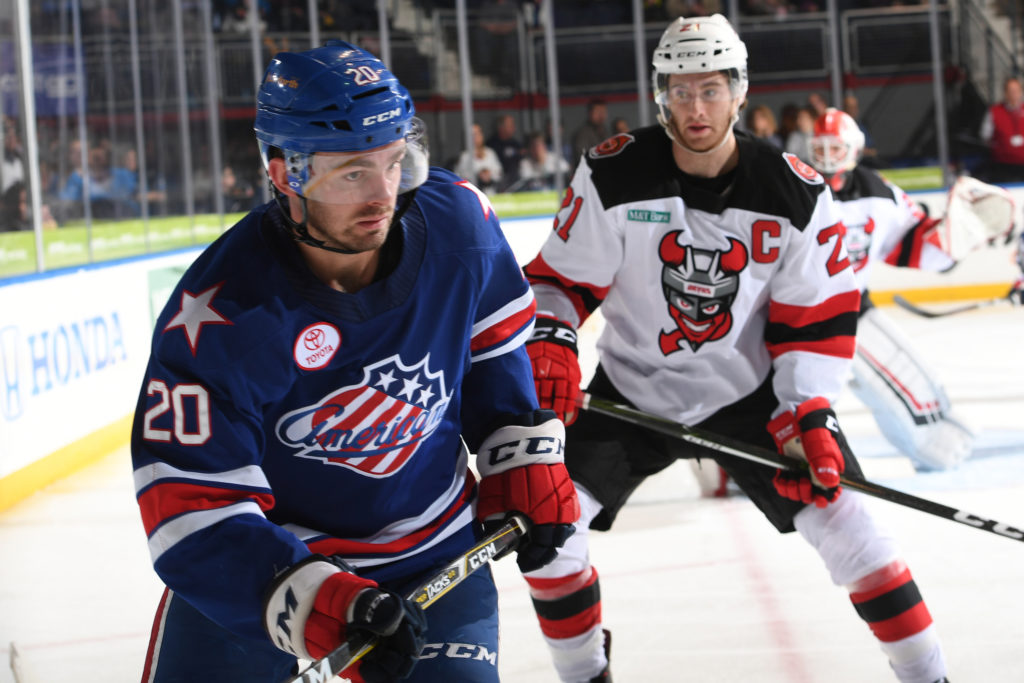
By KEVIN OKLOBZIJA
An adjustment to the veteran rule will go into effect next summer when the new collective bargaining agreement between the American Hockey League and the Professional Hockey Players Association is ratified in the next week.
The game maximum won’t change — skaters who have played in 260 games in the AHL, NHL or European elite league still will be classified a veteran. The new caveat: they must also have turned 25 by the July 1 that precedes the season opener.
It’s a change that will keep a decent percentage of still-young players from reaching the veteran classification.
For instance, assuming Eric Cornel appears in at least 60 games this year for the Rochester Americans, something he has done in each of his first three pro seasons, he’ll still be considered a development player and not a veteran.
In previous years, he would have been considered a vet, and few teams will burn a veteran slot on a bottom-six forward.
The change will also level the playing field between players coming from major junior or the NCAA. Major junior players are usually 20 when they turn pro. Collegiate players often don’t leave school until they’re 22 or even 24.
The ratification process continues for the players and owners are expected to vote on approval in the coming days.
Also of note in the new CBA:
The Pacific will continue to play 68 games
The players continue to fight for schedule equalization but the league and its NHL partners still haven’t been able to agree on any compromise when it comes to the number of games each team plays.
That means the seven teams teams in the Pacific Division will continue to play their preferred 68 games while the league’s other 24 teams play 76.
This will be the fifth year of the oddball alignment, and the longer it goes on, the greater advantage players from Pacific Division teams will have in finding employment in the AHL.
Assuming players on the other 24 teams stay relatively healthy and play 68 to 76 games a year, they will reach the veteran limit of 260 much faster than players in the Pacific. That becomes a huge advantage come contract times.
The PHPA continues to argue that point but understands the position of the NHL teams that favor fewer games and more practice.
“The game disparity was discussed big-time,” said Larry Landon, the head of the PHPA for 25 years. “The goalies in the west are sick of practicing. They face a lot more pucks in practice than they would in a game.
“And the teams out west, they’re almost always on a bus and they’re playing the same teams, so they’re not seeing the true NHL development in terms of travel.”
Landon said an equalized schedule “is the No. 1 key issue” and that the league executives and owners “understand it’s not fair.” The owners just haven’t reached a compromise.
Reduction of 3-in-3s
The players, as well as many NHL teams, continue to push for a reduction in the number of times teams play three games in three nights.
Once a staple in the AHL, because teams look to maximize gate receipts on weekend dates, player health is now more important.
In 2015-16, teams played a total of 170 three-in-threes. It has declined every year since: to 161, to 129, to 116 and to 92 this year.
“That’s for player safety,” Landon said. “We pushed hard for that.”
The Amerks have just two, which is why they have 12 Wednesday home games.
No player health care contributions
The owners were hoping to have players subsidize a percentage of health insurance premiums but the PHPA successfully fought to avoid the fee.

Leave a Reply